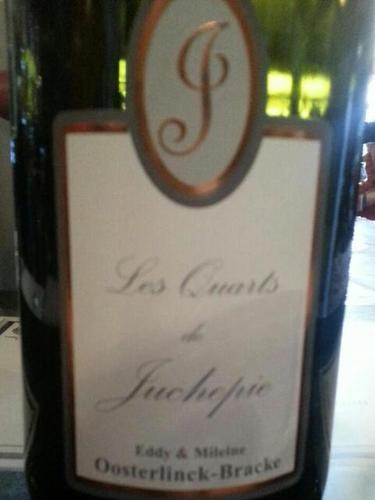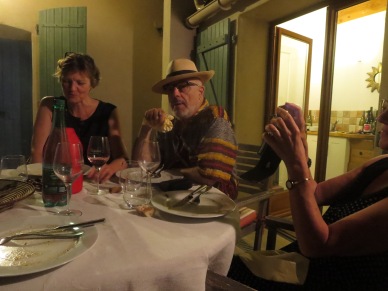
And so, to the Languedoc and I visited a number of domaines, some I knew already some were names I wanted to follow up. I am glad to report that the region more than held its own against the others represented. The Languedoc, and Roussillon, are sources of great wines.
Chateau Maris is in the Minervois area, I enjoyed their wines at Millésime Bio last year and was pleased to taste the new vintages. Some were brut de cuve (straight from the tank so immature) and still a little young for me to really appreciate but there were some good bottles especially Las Combes 2014, 100% Grenache with ripe, round fruit balanced with soft tannins. Lovely now, better in a couple of years.

Domaine Gros-Tollot produce Minervois wines as well as other wines which are made outside the appellation rules. I confess to some bias against the domaine at first, two top Burgundy producers with a side project in the Languedoc? Surely this can’t be honest Languedoc wines. I was proved completely wrong. The wines are excellent, soft fruits with structure and complexity behind them, often from an outstanding use of oak which really does melt into the wine, adding to its aromas and flavours. I liked all the wines such as 2014 La 50/50, Fontanilles 14, and Combettes 14 which is produced from Marselan grapes, very much a Languedoc wine. Best of the bunch for me was La Ciaude 14 made from one vineyard of Syrah, Carignan and a little Grenache.

Mas Gabriel is a firm favourite of mine, almost a neighbour in the village of Caux. We enjoyed a chat with Deborah Core as well as tasting the new vintages of some of my favourite Languedoc wines such as the Carignan Blanc Clos Des Papillons. Special mention though for Les Fleurs Sauvages 2015, the rosé is medium coloured, clear though delicate red fruits and scents of those wild flowers. Very clean and dry it is a top quality rosé, which deservedly sells out very quickly.
Le Conte Des Floris comes next, also based in Caux, though the new cellar is in Pézenas. I love the wines of this domaine, I can’t remember a dull one. Driving forces behind the Wine Mosaic project Daniel and Catherine Conte Des Floris make a great Carignan Blanc Lune Blanche, the 13 was excellent. I really liked Carbonifère 12 and Homo Habilis 12 but my favourite was the Carignan Noir wine Basaltique 2014. Classic Carignan red fruits with an earthy, dark side adding complexity and, undoubtedly, longevity. Amazingly long, very fresh, full of flavour – one of my favourite wines of the whole event. This is one of the very best Languedoc domaines.

Alain Chabanon is a renowned Languedoc producer, I am told he takes no prisoners but it was his wife who presented the wines. I have tasted them before, eg at last year’s Montpeyroux Portes Ouvertes, but they were on better form here. Campredon 14 and Saut De Côté 12 were both very good but my star was Les Boissières 2012. A classic Languedoc blend of Grenache/ Syrah/ Mourvèdre there was a depth of red fruits on the nose and in the mouth with complexity from 24 months of maturing before bottling. I preferred these three wines with classic Languedoc cépages to the more famous Merlot based wines which he makes. Incidentally his website is terrific with a short video of him presenting each of the cuvées and good technical detail.
Domaine De La Marfée is another which I would consider to be one of the very best Languedoc producers, and another I know thanks to Leon. I highlighted every single one of the wines in my notebook, from the lovely Blanc 13 to the most structured of their wines Champs Murmures 12. Complex, full, fruity, Della Francesca 12 and Les Vignes Qu’On Abat 12 were equally good but I actually chose the simplest of their red wines as my star on this occasion. Les Gamines 2013 is Mourvèdre/ Syrah and a little Grenache with a lighter structure than the other reds but no less complexity and fruit. I liked it so much that when we went out to eat at Trinque Fougasse in Montpellier that night I chose this wine to accompany the excellent food. Rare to find a whole range which is outstanding but Domaine De La Marfée achieves it.

Domaine Canet Valette is yet another Languedoc star name, this time from the St. Chinian area. The reds are the stand out wines, Marc Valette described Antonyme as a vin de soif, his beaujolais, and it is a good everyday wine. I have often bought bottles of Une Et Mille Nuits in the past and the 2013 has delicious soft red fruits. The most famous name here though is Maghani and with reason. Marc served three vintages, 08, 10 and 14 and though the older vintages showed just how well it ages it was the Maghani 14 which I liked most. Concentrated and tannic still (this was a bottle made just for the event) there is an enormous depth of red fruits and real power, yet beautifully balanced.

With Marc Valette
Mas Des Capitelles is a Faugères producer whose Carignan, Loris, was a wine which I really liked at a Millésime Bio offline where tasting reds was difficult. I wondered how in better conditions their wines would hold up and I am delighted to say they were even better. Catiède is classic Faugères from a vineyard under biodynamic conversion, 13 and 14 were good. The Vieilles Vignes 13 and 14 were even better, nice gentle use of oak to add complexity and extra depth from the greater use of Mourvèdre. Loris was good again, a new favourite of mine. Then we came to a series of three wines which the Laugé family make only in special years when they have an exceptional crop of one grape. Collection no. 1 2007 was made from Mourvèdre (with a small amount of Carignan and Syrah), and was chosen by the magazine Terre De Vins as one of their top 12 Languedoc wines. And for once I agree with a magazine! Complexity in a bottle, still fresh and youthful after all these years, great wine in short. Collection No. 2 is from 2011 and this time it was the Syrah which was exceptional and so dominates this wine. And no spitting this wine, I drank my glass. The Syrah leaps from the glass with its dark and red fruit aromas, the flavours match up and are deep and long. Great Syrah, great Faugères. I was also treated to a sample of the Collection No. 3 which will again be Mourvèdre led and it didn’t disappoint. Hard to choose just one wine but Collection No. 2 and that memorable Syrah just edges it for me.
Faugères is, in my opinion, the Languedoc’s star region and I enjoyed meeting up with other favourite producers in their area of Vinisud (incidentally it was very useful to have the producers from one region all in on area). My friend and top class producer Brigitte Chevalier of Domaine De Cébène was there; Jérôme Py of Causse Noire whose wines are getting better and better including a lovely Mathias 2011; and Jérôme Rateau of Haut Lignières as well as his eponymous range including an excellent Sur Le Fil 14 which is not yet bottled.
Finally it was a pleasant surprise to run into one stand just as I was preparing to leave Vinisud. Les Beaux Nezs Rouges was a group of natural wine producers sharing the stand. Amongst them were three very good producers from Aspiran, David Caer (Clos Mathélisse), Grégory White and Régis Pichon (Domaine Ribiera). I like the wines of all three and it was good to finish the salon on a high with a just a hint of the new style of winemaking. (More on David Caer on my wine of the week page.)

Régis and Grégory beneath their red nose images
A very enjoyable salon, lots of good wines and a range of food stalls, wine accessories and various wine related activities. This is a salon for the trade and lots of business was being done all around. At the heart though is the wine and, happily, it remained the star of the show.
Part 1 of my Vinisud experience is here.




















































